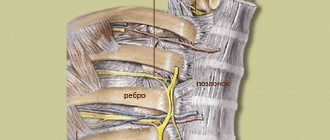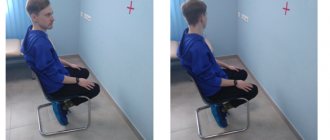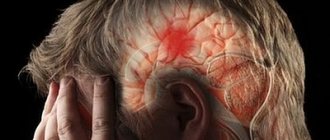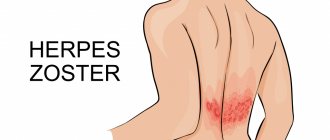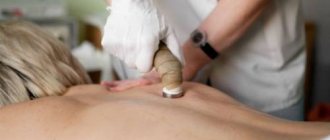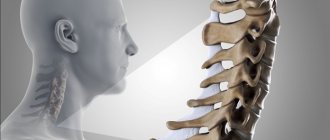Intercostal neuralgia
This is a pain syndrome caused by damage to the peripheral nerves of the chest. Appears due to inflammation, irritation or pinching of the nerve roots in the intercostal space. Intercostal neuralgia is not a disease - it is a syndrome that can appear against the background of various pathologies. Vertebrogenic thoracalgia (as intercostal neuralgia is called) is a general concept that refers to pain that occurs in the chest area. They can appear for no particular reason, or can serve as a sign of various diseases.
Symptoms may resemble pain from a heart attack, pneumonia or pleurisy, diseases such as pancreatitis and others. A characteristic symptom is an increase in pain when coughing, laughing, moving, bending the body and decreasing at rest and with muscle relaxation. This is a distinctive feature of intercostal neuralgia, which allows it to be differentiated from symptoms of heart disease or other pathologies. But you shouldn’t take risks and try to diagnose yourself. The cost of a mistake can be higher than the prolonged pain syndrome.
The principles of treatment and symptoms of intercostal neuralgia in men and women are similar. The main manifestation is pain:
- Paroxysmal, occurring on its own.
- Monotonous, aching.
- Intensified by movement, deep breathing and exhalation, laughter, coughing.
- Occurs when pressing on individual points on the front of the chest or side.
- A burning sensation in the area where the nerve is damaged.
- Numbness, “pins and needles” sensation.
The pathology is more common on the left side of the body, and in women, intercostal neuralgia is a fairly common companion to pregnancy. During this period, the growing fetus puts pressure on the organs in the abdominal cavity, which can lead to pinched nerves.
The use of gymnastics for intercostal neuralgia
Therapeutic exercises for intercostal neuralgia have a positive effect on the body, and its advantages are as follows::
- Improving joint mobility.
- Maintaining flexibility.
- Normalization of blood circulation.
- Eliminate sleep problems.
- The appearance of “muscle joy”.
The meaning of the exercises may vary depending on what type of neuralgia we are talking about.
Neuralgia, caused by pinched nerves due to muscle spasm, involves poor circulation, and gymnastics is very useful for restoring it. In addition to this, massage is usually used.
If the neuralgic condition arose due to muscle spasm, then exercise therapy is supplemented with massage
It is also necessary that if neuralgia occurs not due to muscle spasms, but due to spontaneous impulses in the nerves, gymnastics may not help, but only increase the pain.
Physical education can be useless and even harmful in the presence of pain caused by swelling of the nerve in the so-called “bottlenecks”. This condition is compression ischemic neuropathy. Sometimes surgery may be indicated to eliminate swelling, and only after surgery can exercise therapy be indicated, which will help relieve pain and strengthen the muscles.
Exercises should only be prescribed by a doctor. You cannot carry out such therapy on your own, as the condition can only worsen. First, the doctor must assess the patient’s general condition, diagnose the severity of the disease, and identify additional symptoms of intercostal neuralgia.
It is very important to remember that gymnastics can begin no earlier than 3-4 days after the passage of the characteristic symptoms of the disease.
Physical therapy has contraindications, which include the following::
- Presence of pain syndrome.
- Spinal diseases.
- Inflammatory processes (even without their characteristic discomfort).
- Pregnancy.
Also, you cannot do exercises if bed rest has been prescribed, and if the doctor has not prescribed gymnastics.
Causes
Intercostal neuralgia can be caused by various reasons. Basic:
- Poor posture, injuries, intervertebral hernias, osteochondrosis.
- Hypothermia, which led to poor circulation.
- Infectious and other diseases that lead to nerve damage. For example, destruction of the nerve sheath in multiple sclerosis.
- Neoplasms that compress nerve roots.
- Muscle spasms, prolonged tension during sudden movements or prolonged uncomfortable body posture.
- Operations.
- Pathologies of internal organs.
Useful video - Intercostal neuralgia can be easily removed
Bubnovsky's exercises
Doctor of Medical Sciences Sergei Bubnovsky has developed an original method for treating pain in various pathologies of the musculoskeletal system. It is also recommended to duplicate each element 10 times.
- Lie flat on the floor with your limbs extended. As you exhale, raise your pelvis above the floor, squeezing your buttocks, and lower it as you inhale.
- Place your hands behind the back of your head, bend your knees. Press your hips towards your stomach and ribs and at the same time lift your head and shoulders off the horizontal surface. The chin should touch the chest.
- Take a knee-elbow position and pull your body forward without bending your lower back.
- In the same position, lower yourself down on your elbows, bringing your shoulders closer to the floor.
- Now you need to straighten your arms and rest your palms on the floor. As you inhale, bend your back down and throw your head back. As you exhale, straighten your spine.
- Similar to the previous task, we either bend our back down or bend it up.
- Standing on all fours, we alternately shift our body weight to the right and then to the left leg, while extending the same arm forward.
Attention!
Doing such gymnastics through pain is prohibited. If the movements simply cause discomfort, then this is acceptable. And if severe pain occurs, the exercise should be stopped.
Stretching the thoracic muscles
This gymnastic complex will relieve the nerve trunks from compression by the structures of the musculoskeletal system. We do 6 approaches.
- We place the left hand on the sternum, the right hand on the back of the head. We lean to the left, putting our right elbow up. Then we change sides.
- We get on all fours. We place our left hand on the collarbone of the same name. We turn the body to the left, extending the elbow upward. We repeat similarly with the second hand.
- Similar to the previous task, we put one hand behind our back and perform a turn according to the same pattern.
- Take light dumbbells. We lie down on the floor, placing our hands with dumbbells above our heads. Raise them up perpendicular to the body.
- As in the previous task, we pull the dumbbells up, only the arms should initially be spread on different sides.
Yoga
Elements of yoga must be performed strictly during the period of remission. This is more of a preventative rather than a curative measure. Yoga asanas affect not only the thoracic region, but also the entire spinal column as a whole, the abdominal muscles, and the functioning of the internal organs. Each pose should be held for at least 5 seconds.
- "Mountain Pose" We stand straight, arms at our sides, feet joined together, stomach slightly pulled in, back straightened. We stretch the top of our head towards the ceiling.
- "Half Boat Pose." We lie on our backs, bend our legs at the knees, lift our head and shoulders up, stretch our arms forward, and press our lower back to the floor. Then we straighten our knees, keeping our legs suspended.
- "Cobra Pose." We turn over onto our stomach, join our legs, and rest our hands on the floor under the shoulder joints. Gradually straighten your arms and raise your head and body upward, resting on the floor only with your pubis and legs. Try not to bend your lower back too much. Tilt your head back.
- "Tree Pose." We stand up straight. We bend the right leg, move it outward, and place the sole of the sole with the toes down on the inner surface of the left thigh. As you inhale, raise your arms above your head, bringing your palms together, fingers pointing upward. We breathe deeply and measuredly. Then we duplicate the pose, changing legs.
Note!
It is almost impossible to perform all the asanas correctly at once. Therefore, several yoga sessions should be conducted with an instructor who will correct and guide your actions.
Diagnostics
Intercostal neuralgia can be a symptom of many diseases - from cardiovascular pathologies to diseases of the internal organs of the abdominal cavity and chest. It is impossible to independently determine the cause only from existing complaints. A consultation with a neurologist and a comprehensive diagnosis is necessary to ensure that there are no diseases of the heart, lungs, or digestive system.
Particular attention is paid when diagnosing and treating intercostal neuralgia on the left side. Acute pain in the heart may be a sign of a heart attack. Symptoms usually differ - for example, with heart problems, cold sweat appears and shortness of breath bothers you, the pain does not decrease with rest when the muscles relax. But making a diagnosis based only on symptoms is wrong. The doctor is responsible for the life and health of the patient, which means he needs confidence in the diagnosis and correctness of treatment.
The procedure for examining a patient with suspected intercostal neuralgia is as follows:
- Questioning the patient about complaints and the characteristics of their occurrence.
- Examination to find the location of the pain.
- Setting up a preliminary diagnosis.
- Carrying out examinations to confirm intercostal neuralgia, its causes and prescribe the treatment that will be required in a particular case.
The following diagnostic methods can be used:
- Magnetic resonance imaging or computed tomography is a study that will provide detailed and highly accurate images of tissues and pathology in them.
- ECG – monitoring of heart function to exclude cardiovascular diseases.
- Ultrasound of the heart or other internal organs, diseases in which may have similar symptoms.
- X-ray of the lungs to exclude pneumonia, pleurisy and other diseases in which there are complaints of chest pain.
Diagnostic methods are selected individually depending on the nature of the pain and its location, and the patient’s condition. In some cases, other specialists are involved in diagnosis and treatment - a cardiologist, gastroenterologist, pulmonologist.
Beneficial features
Performing special gymnastic exercises can significantly improve the patient’s well-being and speed up recovery. The main beneficial properties of exercise therapy for intercostal neuralgia:
- improved blood circulation;
- relieving spasms from the muscles of the back and thoracic region;
- general strengthening effect on the body;
- elimination of congestion in bone joints and joints.
Treatment
The goals of therapy for intercostal neuralgia: reduce pain, eliminate the cause of pinching or inflammation.
For this purpose, drug treatment is prescribed using:
- Muscle relaxants to relieve muscle spasms.
- Neuroprotectors for the protection and restoration of nerve cells.
- Painkillers and injection therapeutic blockade with various drugs. It has a strong analgesic effect, relieves swelling and eliminates muscle spasms.
Drug treatment of intercostal neuralgia is complemented by physiotherapy. The following physiotherapeutic procedures can be used:
- Exercise therapy is an individually selected set of exercises to relax spastic muscles, improve blood circulation and lymph flow in the problem area. Exercise therapy is effective for the treatment and prevention of neuralgia, but it can only be done if there are no contraindications. It is important not to cause harm, which is possible with home exercises. What exercises will be effective, how exactly to do them, the number of repetitions - all this will be advised by a physical therapy doctor. The safest and most effective classes are under the supervision of a physical therapy instructor in individual or group classes.
- Laser therapy uses light energy to increase blood circulation, relax muscles, and reduce pain and inflammation.
- Magnetotherapy - the effect of an electromagnetic field on the body leads to the elimination of congestion, improvement of blood circulation, and reduction of pain syndromes.
- Diadynamic therapy, galvanization, exposure to interference currents and other procedures with electric current of varying power and frequency. They have a healing effect on soft tissues, improving blood circulation and lymph outflow, relaxing muscles and providing an analgesic effect.
- Electrophoresis is a procedure that improves the penetration of drugs into soft tissues and accelerates their action.
- Therapeutic massage and manual therapy are methods of influencing the body with the hands of a doctor. They allow not only to reduce or completely relieve pain, but also to treat the causes of intercostal neuralgia - pathologies of the spine, functional blocks in its work. What exactly to use - acupressure, segmental or other types of massage - is decided by a chiropractor or massage therapist.
- Acupuncture (acupuncture) – injections with thin needles into biologically active points on the body to relieve pain and normalize the functioning of internal organs.
Treatment of intercostal neuralgia on the right or left side of the chest, in the side with the help of physiotherapeutic procedures is carried out in several procedures. A full course usually consists of 10-15 sessions. Appointments are always individual.
Types of exercise therapy for intercostal neuralgia
There are a large number of types of gymnastics that can be used for intercostal neuralgia. Let's look at the most common ones.
Set of exercises
A general set of exercises can be started after the pain subsides..
The first exercise is quite simple. You need to take a deep breath and hold your breath. Then purse your lips and slowly release the air. This exercise is repeated several times. In order to relieve the syndrome, you need to relax the muscles so that the nerve endings are freed.
Further gymnastics includes the following exercises:
Familiarize yourself with the general set of exercises. Place your feet shoulder-width apart and do 5 bends to the left and right sides. Hands should be kept on your sides, movements should be smooth and slow.- In the same position, bend your arms and raise them to your chin. Do several repetitions to the sides so that your pelvis does not move.
- Do those 10 (or more) squats while holding onto a chair. At the same time, the back should remain straight.
- While sitting on a chair, place your hands behind your head, bend back, then return to the starting position. Do up to 10 times.
- While lying on your back, bend your legs and try to reach your nose with each of them.
- Lying on your stomach, stretch your arms along your torso, lift your head and legs at the same time and try to arch as much as possible.
Gymnastics Dikul
Did you know that...
Next fact
Valentin Dikul's exercises help restore muscle function. The author of the technique himself believes that due to a lack of stress, the human motor system relaxes. As a rule, the doctor selects exercises individually, taking into account the characteristics of a particular patient.
In the Dikul method there is one effective exercise that perfectly combats pain.:
- Lie on your stomach, extend your arms forward and place your chin on the floor.
- Keep your head and feet still, arch your back. Lock in this position for a few seconds and smoothly return to the starting position.
- You need to repeat the exercise about ten times.
Using this method, over time you should increase the fixation of the torso in an arched state. Over time, the duration should reach a minute.
Bubnovsky's exercises
Dr. Bubnovsky is against the use of medications for intercostal neuralgia; he believes that the pathology can be eliminated through simple movements. Some exercises involve the use of special simulators developed by the author himself.
The simplest exercises for beginners that do not require equipment are the following::
- While standing on all fours, you need to alternately arch your back down and up. The exercise is done at a slow pace ten times.
- Standing on all fours, take a deep breath and bend down. As you exhale, straighten out. The exercise is repeated ten times.
- From the same position, shift your body weight to your left leg and extend your left arm forward. The same is repeated for the second side. Movements should be smooth. Do 5 repetitions for each side.
- Lean on your elbows and knees. Without bending, stretch your torso forward 10 times.
- Leaning on your elbows and knees, as you exhale, lower yourself down on your elbows, and as you exhale, rise up. Number of repetitions - 5.
- In a lying position with your hands behind your head and legs bent, press your chin to your chest, bend your torso and try to lift your head, legs and shoulders off the floor. Repeat the exercise three times.
- Lying on your back, place your arms along your torso, as you exhale, lift your pelvis, and as you inhale, lower it. Repeat ten times.
Video: “What to do for pain in the thoracic region?”
Pay attention to some useful back exercises for various diseases:
- You can find out what Crocodile gymnastics is in the following article
- More information about Bubnovsky’s exercise for the spine against disc herniation is described on the page
- Gymnastic exercises by Shamil Alyautdinov for the back with a herniated spine
- To find out what exercises to do if you have a pinched nerve in your neck, follow the link
- How beneficial is Qigong gymnastics for the spine?
- You can read about a set of exercises for the spine by Academician Norbekov here
- Find out how to do Dr. Popov's exercises to treat your back by going here
Stretching the thoracic muscles
Stretching exercises are good for the chest and spine. To perform the exercises you will need two small dumbbells or bottles filled with water. The training is carried out in a lying position, with the head hanging down slightly.
Place your hands with weight behind your head, inhale and raise your arms, then exhale and lower them. Repeat 20 times.
Stretch your arms with weight to the sides, when you inhale, lift them above your chest, when you exhale, lower them and return to the starting position. Repeat 20 times.
Yoga
Yoga is used only for the prevention of pathology. Yoga is also useful for intercostal neuralgia, as it helps tone the body and strengthens bones and muscles. You can start using it after treatment, when a specialist confirms that you are healthy.
Unlike therapeutic exercises, yoga does not involve a specific set of classes , so the following factors must be taken into account:
- Sudden random movements can cause pain.
- Large-scale movements that strongly stretch the parts between the ribs can also lead to pain.
- Breathing is very important in yoga. It can be abdominal and thoracic. The latter is not recommended for intercostal neuralgia, as it can provoke shooting pains and complicate the pathology.
Prevention
The following recommendations help to avoid the appearance of intercostal neuralgia:
- Moderate physical activity to strengthen the muscle frame and maintain their elasticity.
- Maintaining correct posture.
- Healthy eating.
- Daily routine and alternation of work and rest time.
- Protection against hypothermia.
You should not endure the pain of intercostal neuralgia and worry about its causes - consult a doctor to be sure that there are no serious pathologies and for quick relief of symptoms.
Why classes are useful
Normalized physical activity has a beneficial effect on the body for a number of reasons:
- improving blood flow to nerve endings helps restore damaged nerve endings and tissues;
- increasing resistance to stress reduces the risk of neuralgia;
- strengthening the immune system.
When doing therapeutic exercises, new neural connections are formed that make the body forget about the formation of pain.
Spinal diseases caused by a sedentary lifestyle are common causes of intercostal neuralgia. Exercise therapy helps to relieve these disorders, thereby reducing the risk of relapse of thoracic radiculitis.
A set of special physical exercises will help normalize the position of the spine, relieve tension in muscle tissue and eliminate possible pinched nerve endings, which reduces pain.
How does physical therapy work?
Exercises for intercostal neuralgia give positive results in the treatment of this pathology. Such physical education is prescribed by a specialist for each patient individually. When selecting exercises you should consider:
- severity of pathology;
- symptomatic picture;
- general condition of the patient.
Gymnastics for neuralgia has a positive effect on the patient by:
- restoration of proper rib mobility;
- elimination of a spasmodic state with a decrease in muscle tone;
- mood lifting, a person becomes cheerful and strong;
- positive effect for pregnant women, avoiding the use of medications.
Rules for performing therapeutic exercises
To obtain the maximum benefit from physical therapy, it is necessary to take into account a number of factors in which it is better to temporarily abstain from exercise:
- acute phase of pathology, which is characterized by severe pain;
- the presence of swelling of the nerves in narrow places, otherwise - tunnel syndrome.
Exercise therapy should begin 2-3 days after the main therapeutic procedures.
When starting physical exercise, you should follow a few simple rules:
- dose the load;
- avoid pain when performing the complex;
- do exercises regularly;
- When choosing a training program, consult a specialist.
There are several techniques that are used for physical therapy for intercostal neuralgia:
- Pilates - effective due to the use of stabilizer muscles and minimal injury, it is also possible to use a mixture of yoga and Pilates;
- V. Dikul’s technique;
- Bubnovsky exercises.
All exercises are performed smoothly, at a measured pace.
Why do you need therapeutic exercises?
It is important to understand that exercises for intercostal neuralgia of the thoracic region must be approved by a specialized specialist. Self-medication often leads to dangerous complications, including disability.
At the first manifestations of the disease, you should seek help from a clinic. It is necessary to make sure that the inflammatory process and swelling do not compress the nerve roots. In this case, you first need to eliminate the attack.
Also, you should not load the body with muscle spasms. The best option under such conditions is to sign up for a relaxing massage.
Exercises for thoracic neuralgia should:
- eliminate unpleasant signs of the disease (pain, swelling, swelling);
- restore the functioning of the circulatory system;
- prevent complications.
Many people write in reviews that exercise therapy normalized sleep, relieved nervous tension, unmotivated aggression and irritability.
